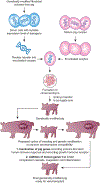Consensus statement on heart xenotransplantation in children: Toward clinical translation
- PMID: 36184321
- PMCID: PMC10124772
- DOI: 10.1016/j.jtcvs.2022.09.001
Consensus statement on heart xenotransplantation in children: Toward clinical translation
Abstract
Keywords: congenital heart disease; genetically engineered; heart; infants; neonates; pediatric; pig; xenotransplantation.
Conflict of interest statement
Conflict of Interest Statement
Dr Cooper is a consultant to eGenesis, but the opinions expressed in the manuscript are his own and not necessarily those of eGenesis. Dr Rothblatt is Chairperson and Chief Executive Officer of United Therapeutics Corporation. Revivicor, Inc, a subsidiary of United Therapeutics Corporation, owns a variety of issued patents and pending patent applications broadly relevant to xenotransplantation. All other authors reported no conflicts of interest.
The
Figures



References
-
- Langin M, Mayr T, Reichart B, Michel S, Buchholz S, Guetholf S, et al. Consistent success in life-supporting porcine cardiac xenotransplantation. Nature. 2018;564:430–3. - PubMed
-
- Rothblatt M. Commentary on achievement of first life-saving xenoheart transplant. Xenotransplantation. 2022;29:e12746. - PubMed
-
- Reardon S. First pig-to-human transplant: what can scientists learn? Nature. 2022;601:305–6. - PubMed
Publication types
MeSH terms
Grants and funding
LinkOut - more resources
Full Text Sources

